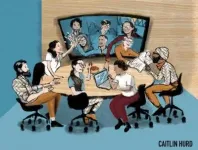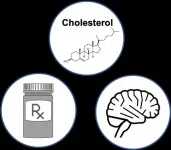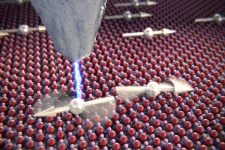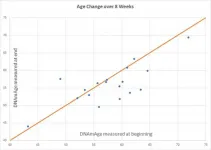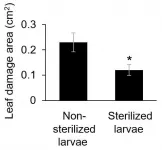INFORMATION:
Work at Rice, Baylor and Northeastern was supported by the National Science Foundation (NSF), the Welch Institute, the National Institutes of Health, the NSF-supported Behavioral Plasticity Research Institute, IBM, the Pawsey Supercomputing Center and Illumina Inc. END
Biologists construct a 'periodic table' for cell nuclei
Project to classify nuclei across the tree of life discovers how to transmute them from one type into another
2021-05-27
(Press-News.org) HOUSTON - (May 27, 2021) - One hundred fifty years ago, Dmitri Mendeleev created the periodic table, a system for classifying atoms based on the properties of their nuclei. This week, a team of biologists studying the tree of life has unveiled a new classification system for cell nuclei and discovered a method for transmuting one type of cell nucleus into another.
The study, which appears this week in the journal Science, emerged from several once-separate efforts. One of these centered on the DNA Zoo, an international consortium spanning dozens of institutions including Baylor College of Medicine, the National Science Foundation-supported Center for Theoretical Biological Physics (CTBP) at Rice University, the University of Western Australia and SeaWorld.
Scientists on the DNA Zoo team had been working together to classify how chromosomes, which can be several meters long, fold up to fit inside the nuclei of different species from across the tree of life.
"Whether we were looking at worms or urchins, sea squirts or coral, we kept seeing the same folding patterns coming up," said Dr. Olga Dudchenko, co-first author of the new study and a member of the Center for Genome Architecture at Baylor and CTBP.
Eventually, the team realized it was just seeing variants on two overall nuclear designs. "In some species, chromosomes are organized like the pages of a printed newspaper, with the outer margins on one side and the folded middle at the other," explained Dudchenko, who also is co-director of DNA Zoo. "And then in other species, each chromosome is crumpled into a little ball."
"So we had a puzzle," said Dr. Erez Lieberman Aiden, an associate professor of molecular and human genetics and Emeritus McNair Scholar at Baylor, co-director of the DNA Zoo and senior author on the new study. "The data implied that over the course of evolution, species can switch back and forth from one type to the other. We wondered: What is the controlling mechanism? Might it be possible to change one type of nucleus into another in the lab?" Aiden also is director of the Center for Genome Architecture and a senior investigator at CTBP.
Meanwhile, an independent team in the Netherlands had discovered something unexpected. "I was doing experiments on a protein called condensin II, which we knew plays a role in how cells divide," said Claire Hoencamp, co-first author of the study and a member of the laboratory of Dr. Benjamin Rowland at the Netherlands Cancer Institute. "But we observed the strangest thing: When we mutated the protein in human cells, the chromosomes would totally rearrange. It was baffling!"
The two teams met at a conference in the Austrian mountains, where Rowland presented his lab's latest work. They soon realized that Hoencamp had hit on a way to convert human cells from one nuclear type to another.
"When we looked at the genomes being studied at the DNA Zoo, we discovered that evolution had already done our experiment many, many times! When mutations in a species break condensin II, they usually flip the whole architecture of the nucleus," said Rowland, senior author on the study. "It's always a little disappointing to get scooped on an experiment, but evolution had a very long head start."
The team decided to work together to confirm condensin II's role. But then the COVID-19 pandemic struck, and much of the world shut down.
"Without access to our laboratories, we were left with only one way to establish what condensin II was doing," Hoencamp said. "We needed to create a computer program that could simulate the effects of condensin II on the chain of hundreds of millions of genetic letters that comprise each human chromosome."
The team turned to Dr. José Onuchic, the Harry C. and Olga K. Wiess Chair of Physics at Rice. "Our simulations showed that by destroying condensin II, you could make a human nucleus reorganize to resemble a fly nucleus," said Onuchic, co-director of CTBP, which includes collaborators at Rice, Baylor, Northeastern University and other institutions in Houston and Boston.
The simulations were performed by a team within Onuchic's lab at CTBP, led by postdoctoral fellow and co-first author Dr. Sumitabha Brahmachari, working with Dr. Vinicius Contessoto, a former postdoc at CTBP, and Dr. Michele Di Pierro, a CTBP senior investigator and currently an assistant professor at Northeastern University.
"We began with an incredibly broad survey of 2 billion years of nuclear evolution," Brahmachari said. "And we found that so much boils down to one simple mechanism, that we can simulate as well as recapitulate, on our own, in a test tube. It's an exciting step on the road to a new kind of genome engineering -- in 3D!"
ELSE PRESS RELEASES FROM THIS DATE:
Seabirds face dire threats from climate change, human activity — especially in Northern Hemisphere
2021-05-27
Many seabirds in the Northern Hemisphere are struggling to breed -- and in the Southern Hemisphere, they may not be far behind. These are the conclusions of a study, published May 28 in Science, analyzing more than 50 years of breeding records for 67 seabird species worldwide.
The international team of scientists -- led by William Sydeman at the Farallon Institute in California -- discovered that reproductive success decreased in the past half century for fish-eating seabirds north of the equator. The Northern Hemisphere has suffered greater impacts from human-caused climate change and other human activities, like overfishing.
Seabirds include albatrosses, puffins, murres, penguins and other birds. Whether they ...
How more inclusive lab meetings lead to better science
2021-05-27
A new paper, published recently in PLOS Computational Biology by a team including UMass Amherst researchers, seeks to help scientists structure their lab-group meetings so that they are more inclusive, more productive and, ultimately, lead to better science.
The word "scientist" might conjure images of lab-coated researchers tending bubbling beakers or building supercomputers, but an enormous amount of scientific work takes place around a conference table during weekly group meetings. "There is plenty of good research showing that diversity and inclusion make the science itself better," says Kadambari Devarajan, one of the paper's co-lead authors and a graduate ...
Changes in how cholesterol breaks down in the body may accelerate progression of dementia
2021-05-27
The blood-brain barrier is impermeable to cholesterol, yet high blood cholesterol is associated with increased risk of Alzheimer's disease and vascular dementia. However, the underlying mechanisms mediating this relationship are poorly understood. A study published in the open-access journal PLOS Medicine by Vijay Varma and colleagues at the National Institute on Aging, part of the National Institutes of Health, in Baltimore, Maryland, suggests that disturbances in the conversion of cholesterol to bile acids (called cholesterol catabolism) may play a role in the development of dementia.
Little ...
Astonishing quantum experiment in Science raises questions
2021-05-27
Quantum systems are considered extremely fragile. Even the smallest interactions with the environment can result in the loss of sensitive quantum effects. In the renowned journal Science, however, researchers from TU Delft, RWTH Aachen University and Forschungszentrum Jülich now present an experiment in which a quantum system consisting of two coupled atoms behaves surprisingly stable under electron bombardment. The experiment provide an indication that special quantum states might be realised in a quantum computer more easily than previously thought.
The so-called decoherence is one of the greatest enemies of the quantum physicist. Experts understand by this the decay of quantum states. This inevitably occurs when the system interacts with its environment. In ...
Three years younger in just eight weeks? A new study suggests yes!
2021-05-27
A groundbreaking clinical trial shows we can reduce biological age (as measured by the Horvath 2013 DNAmAge clock) by more than three years in only eight weeks with diet and lifestyle through balancing DNA methylation. A first-of-its-kind, peer-reviewed study provides scientific evidence that lifestyle and diet changes can deliver immediate and rapid reduction of our biological age. Since aging is the primary driver of chronic disease, this reduction has the power to help us live better, longer. The study, released on April 12, utilized a randomized controlled clinical trial conducted among 43 healthy adult males between the ages of 50-72. The 8-week treatment program included diet, sleep, exercise and relaxation ...
The new species of bacteria killing palms in Australia
2021-05-27
The bacterium, which they named Candidatus Phytoplasma dypsidis was found to cause a fatal wilt disease. This new discovery was reported in the International Journal of Systematic and Evolutionary Microbiology.
In 2016, several ornamental palms within a conservatory in the Cairns Botanic Gardens, Queensland, died mysteriously. A sample was taken from one of the diseased plants and investigated by Dr Richard Davis and colleagues from the Australian Government Department of Agriculture, Water and the Environment, and state and local government. They compared the characteristics and genome of the bacterium identified as the cause of the disease and found the ...
Exploring optimization of duplex velocity criteria for diagnosis of ICA stenosis
2021-05-27
Study Exploring Optimization of Duplex Velocity Criteria for Diagnosis of Internal Carotid Artery (ICA) Stenosis Published Online
Online first in Vascular Medicine, researchers from the Intersocietal Accreditation Commission (IAC) Vascular Testing division report findings of their multi-centered study of duplex ultrasound for diagnosis of internal carotid artery (ICA) stenosis. 1
The study was developed in response to wide variability in the diagnostic criteria used to classify severity of ICA stenosis across vascular laboratories nationwide and following a survey of members of IAC-accredited ...
Aging: Clinical trial on potential reversal of epigenetic age using a diet and lifestyle
2021-05-27
Aging published "Potential reversal of epigenetic age using a diet and lifestyle intervention: a pilot randomized clinical trial" which reported on a randomized controlled clinical trial conducted among 43 healthy adult males between the ages of 50-72. The 8-week treatment program included diet, sleep, exercise and relaxation guidance, and supplemental probiotics and phytonutrients. Genome-wide DNA methylation analysis was conducted on saliva samples using the Illumina Methylation Epic Array and DNAmAge was calculated using the online Horvath DNAmAge clock (also published in Aging). The diet and lifestyle treatment was associated with a 3.23 years decrease in DNAmAge compared with controls. DNAmAge of those in the treatment group decreased by an average 1.96 ...
Books on health, economic inequalities in Latin America, Caribbean shed light on content, impact of health policies
2021-05-27
More than 500,000 people have died from COVID-19 in Latin America and the Caribbean, demonstrating the health and economic inequalities throughout the region. A new article analyzes seven books* that discuss these inequalities, including questions of who gets health care and what interdependent roles societies, social movements, and governments play. To end inequality in the region, the author calls for a universal approach to health care.
The article, by a professor at Carnegie Mellon University (CMU), appears in the June 2021 issue of Latin American Research Review, a journal published by the Latin American Studies Association.
"These books break new ground and contribute to our understanding of some of the most important health ...
Partners in crime: Agricultural pest that relies on bacteria to overcome plant defenses
2021-05-27
Although insect larvae may seem harmless to humans, they can be extremely dangerous to the plant species that many of them feed on, and some of those plant species are important as agricultural crops. Although plants cannot simply flee from danger like animals typically would, many have nonetheless evolved ingenious strategies to defend themselves from herbivores. Herbivorous insect larvae will commonly use their mouths to smear various digestive proteins onto plants that they want to eat, and when plants detect chemicals commonly found in these oral secretions, ...
LAST 30 PRESS RELEASES:
Why nail-biting, procrastination and other self-sabotaging behaviors are rooted in survival instincts
Regional variations in mechanical properties of porcine leptomeninges
Artificial empathy in therapy and healthcare: advancements in interpersonal interaction technologies
Why some brains switch gears more efficiently than others
UVA’s Jundong Li wins ICDM’S 2025 Tao Li Award for data mining, machine learning
UVA’s low-power, high-performance computer power player Mircea Stan earns National Academy of Inventors fellowship
Not playing by the rules: USU researcher explores filamentous algae dynamics in rivers
Do our body clocks influence our risk of dementia?
Anthropologists offer new evidence of bipedalism in long-debated fossil discovery
Safer receipt paper from wood
Dosage-sensitive genes suggest no whole-genome duplications in ancestral angiosperm
First ancient human herpesvirus genomes document their deep history with humans
Why Some Bacteria Survive Antibiotics and How to Stop Them - New study reveals that bacteria can survive antibiotic treatment through two fundamentally different “shutdown modes”
UCLA study links scar healing to dangerous placenta condition
CHANGE-seq-BE finds off-target changes in the genome from base editors
The Journal of Nuclear Medicine Ahead-of-Print Tip Sheet: January 2, 2026
Delayed or absent first dose of measles, mumps, and rubella vaccination
Trends in US preterm birth rates by household income and race and ethnicity
Study identifies potential biomarker linked to progression and brain inflammation in multiple sclerosis
Many mothers in Norway do not show up for postnatal check-ups
Researchers want to find out why quick clay is so unstable
Superradiant spins show teamwork at the quantum scale
Cleveland Clinic Research links tumor bacteria to immunotherapy resistance in head and neck cancer
First Editorial of 2026: Resisting AI slop
Joint ground- and space-based observations reveal Saturn-mass rogue planet
Inheritable genetic variant offers protection against blood cancer risk and progression
Pigs settled Pacific islands alongside early human voyagers
A Coral reef’s daily pulse reshapes microbes in surrounding waters
EAST Tokamak experiments exceed plasma density limit, offering new approach to fusion ignition
Groundbreaking discovery reveals Africa’s oldest cremation pyre and complex ritual practices
[Press-News.org] Biologists construct a 'periodic table' for cell nucleiProject to classify nuclei across the tree of life discovers how to transmute them from one type into another

